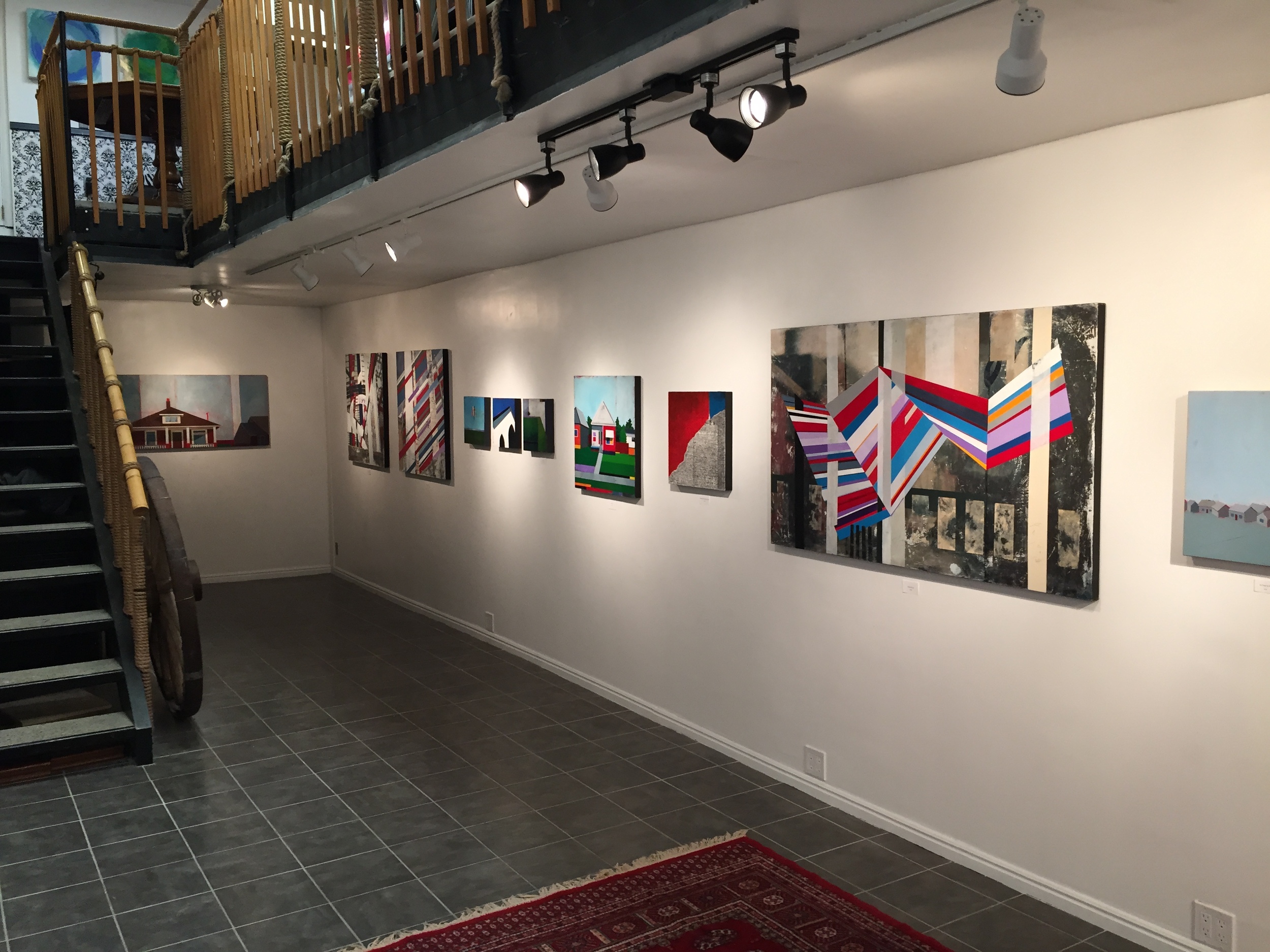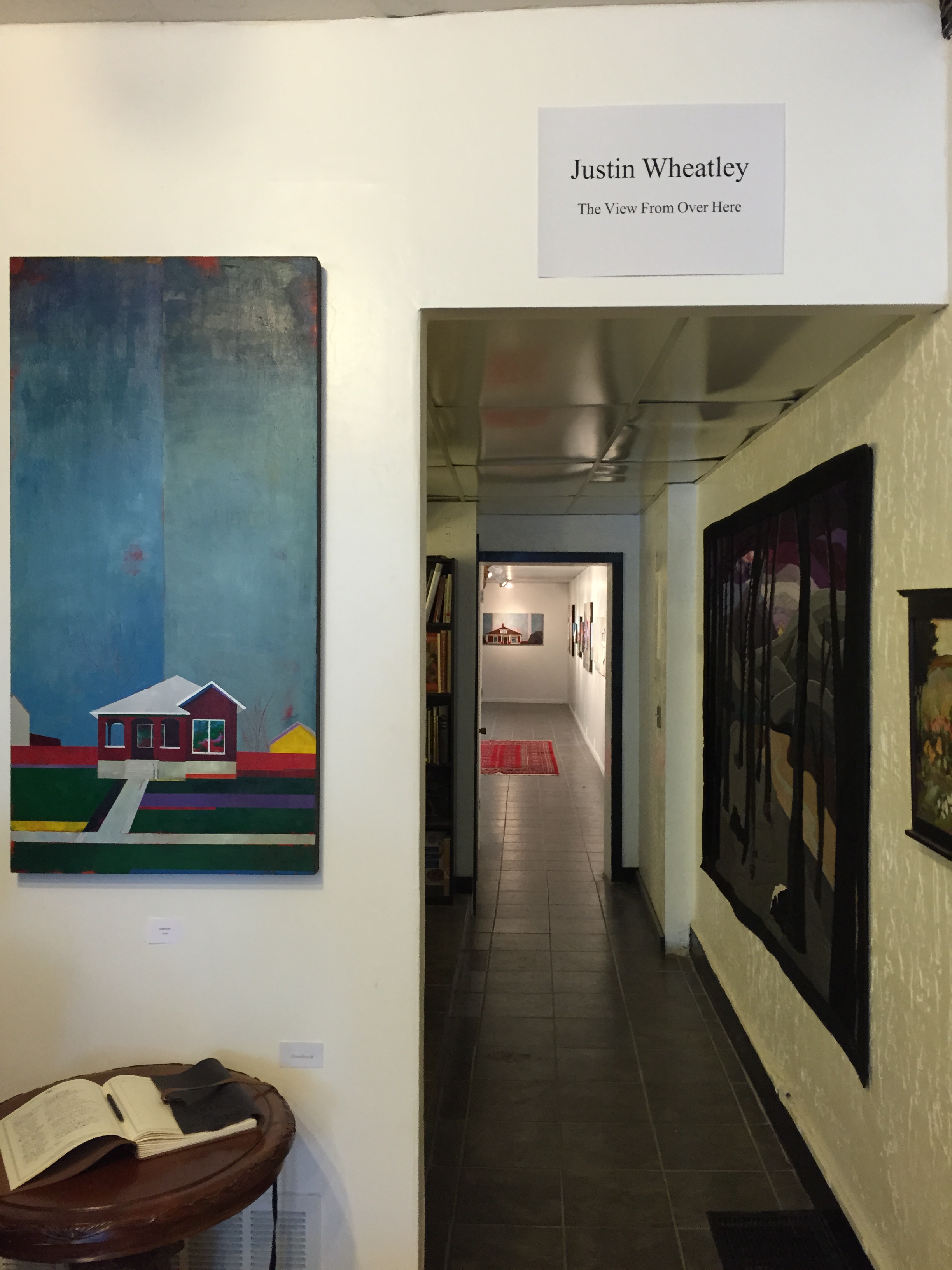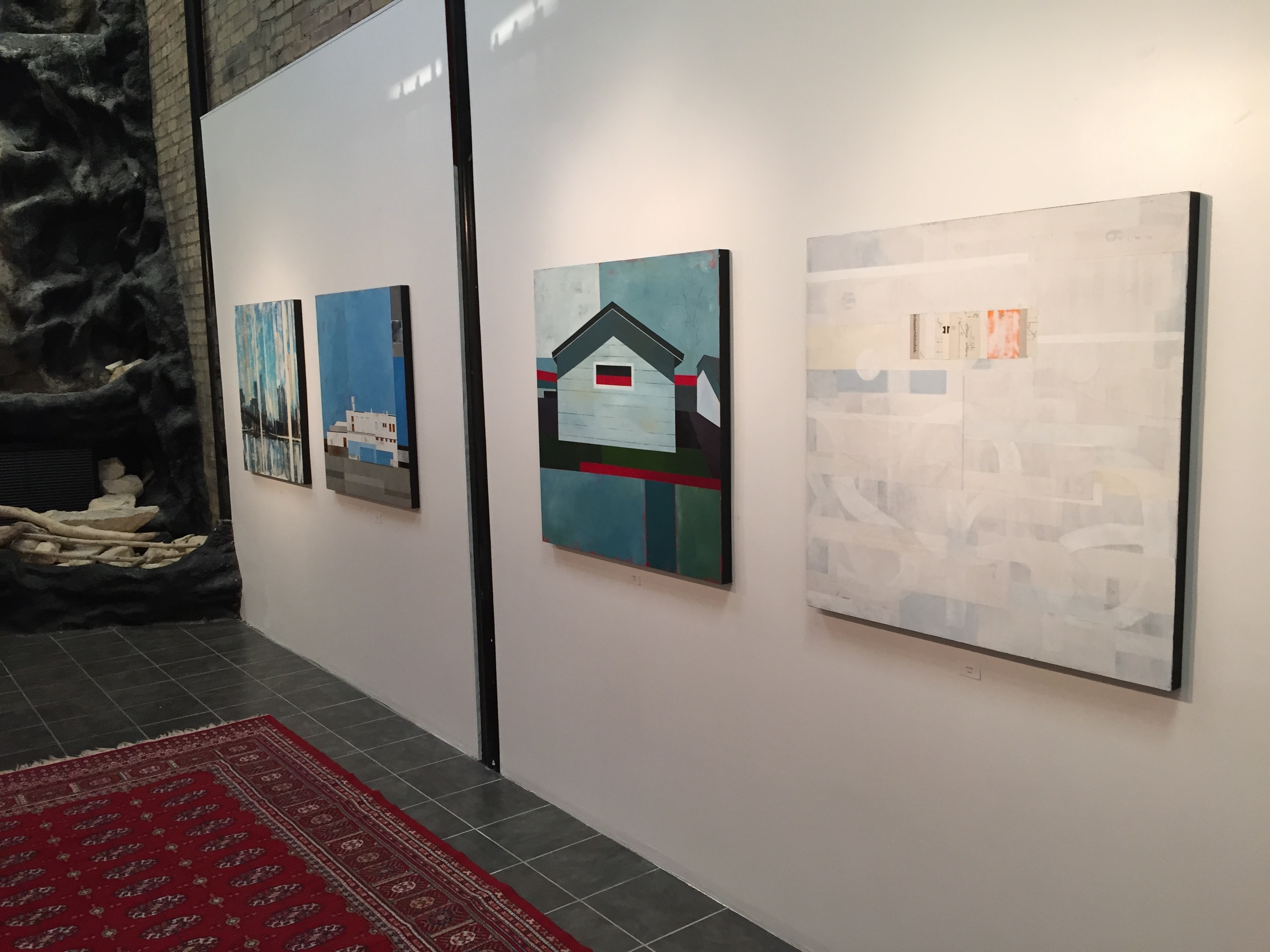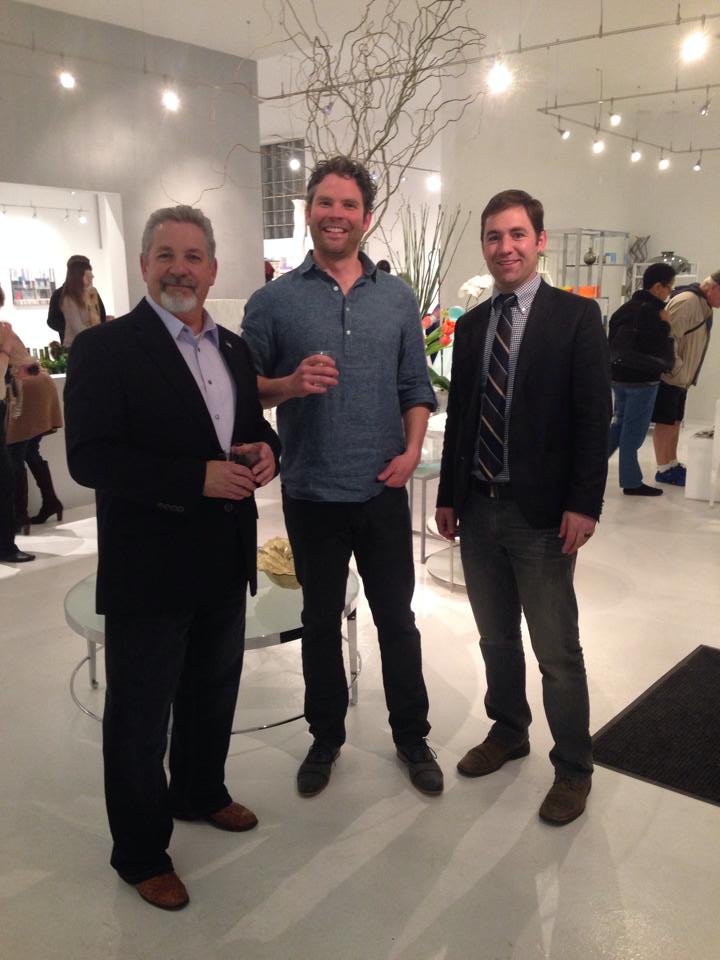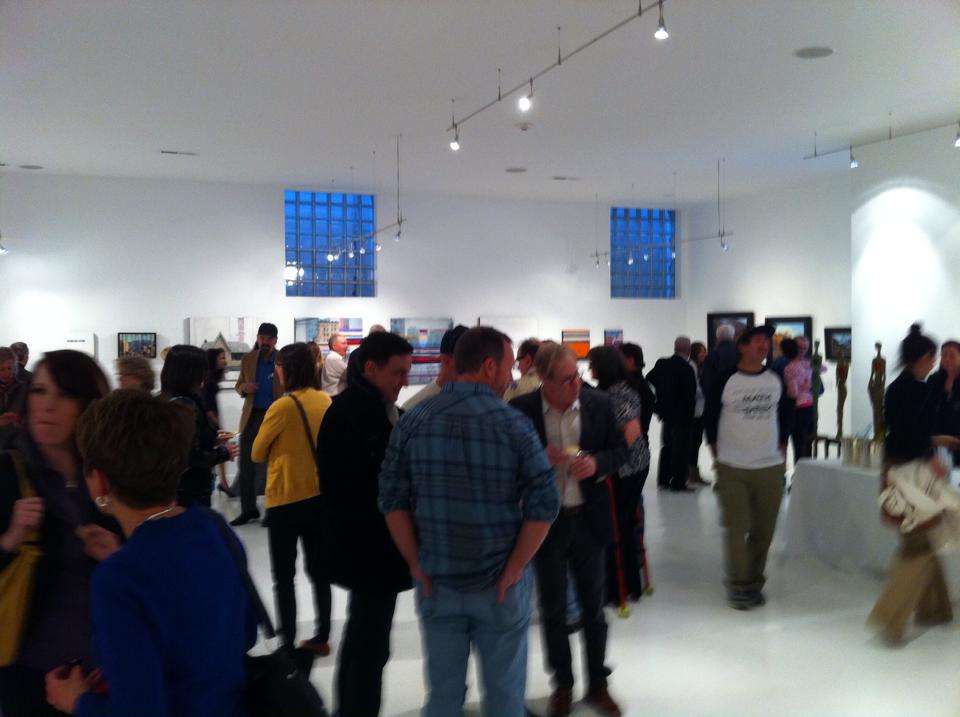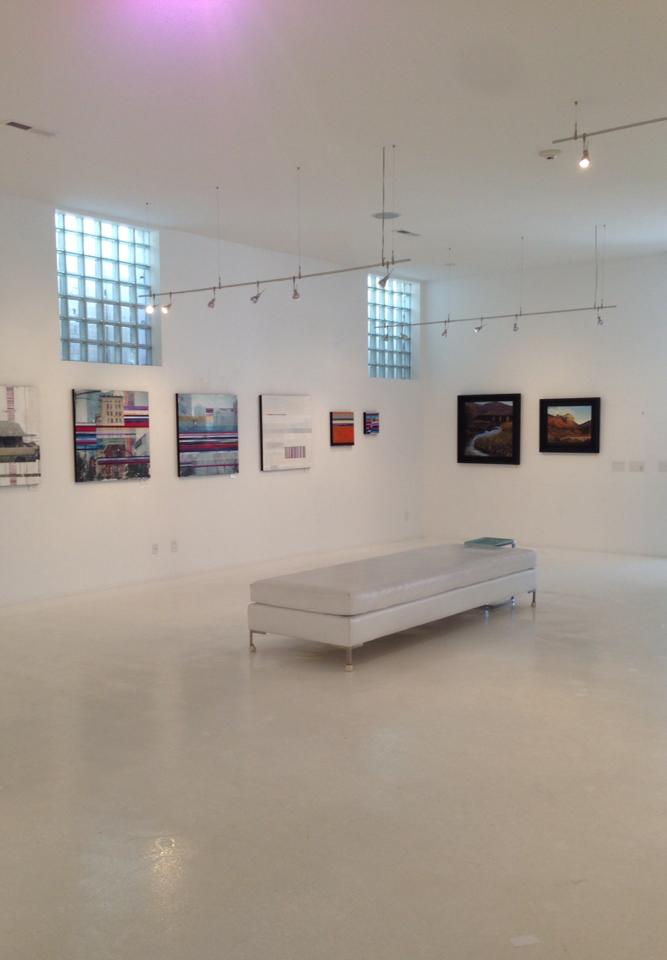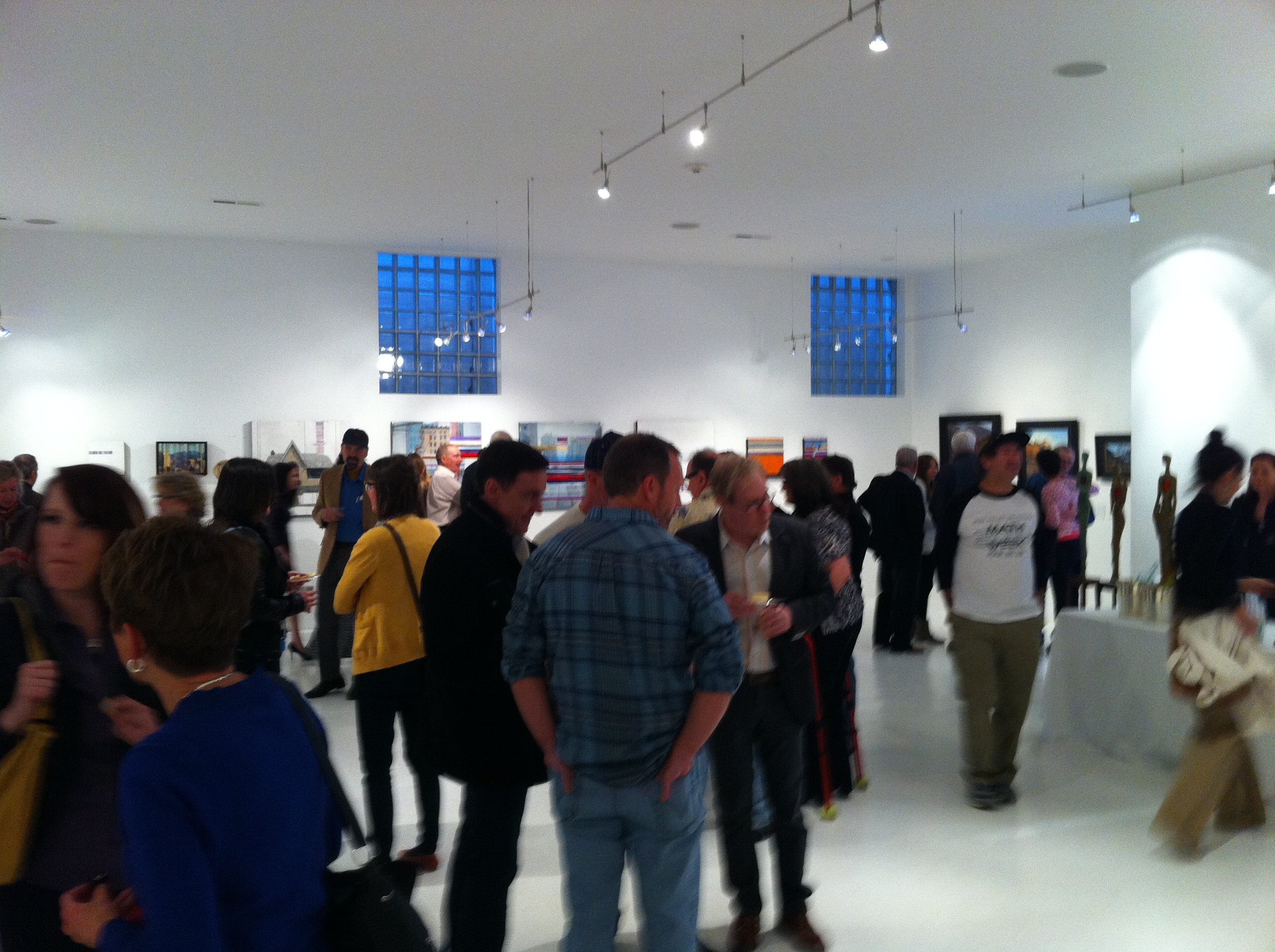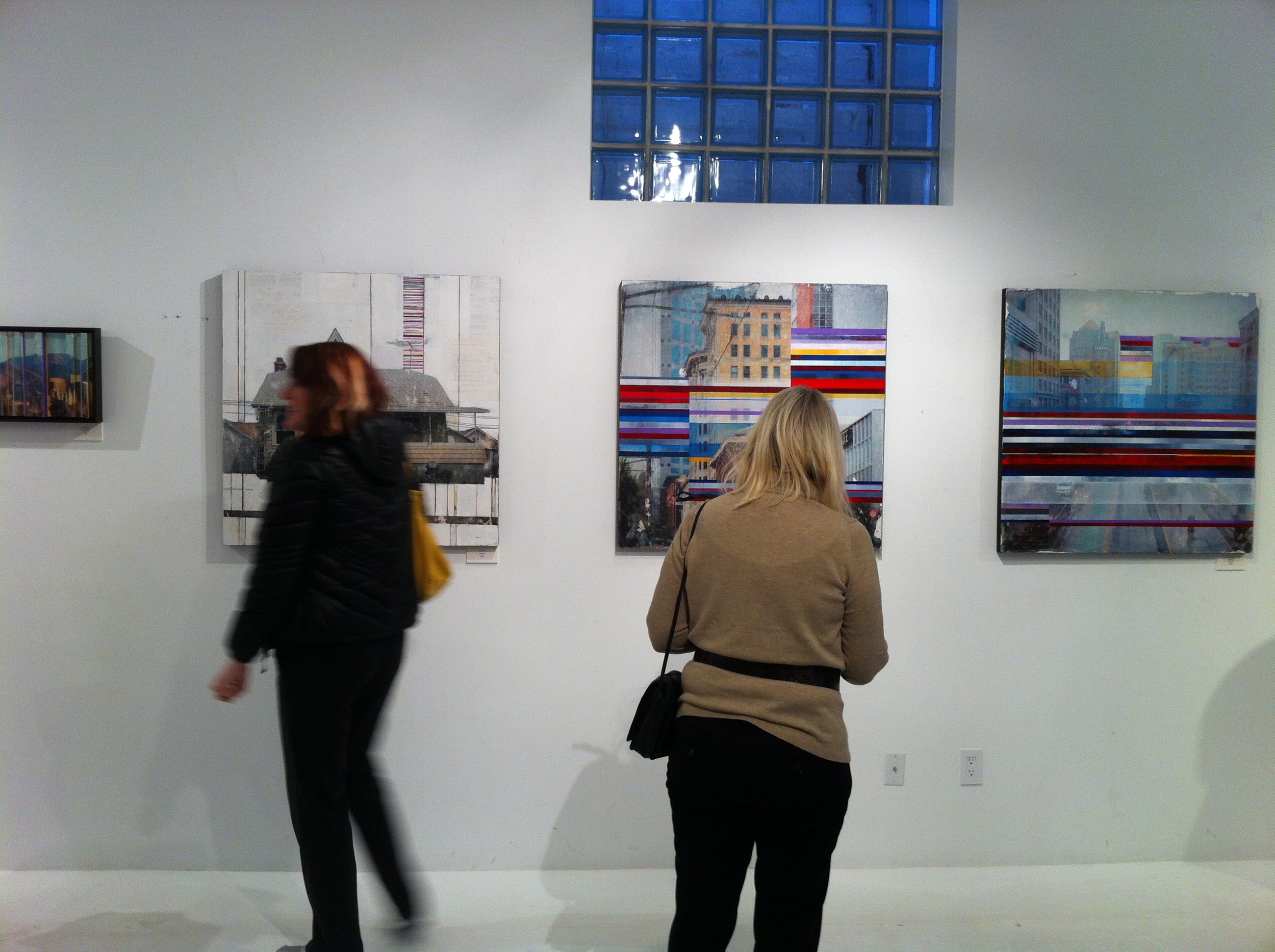Orem Library Interview
Artist Interview: Justin Wheatley
July 17, 2015 · by Orem Public Library · in ...and the Kitchen Sink. ·
Justin Wheatley is an artist with a Bachelor of Fine Arts from Utah State University with an emphasis in drawing and painting and a Master’s in Education from National University. His art show will be at the Orem Library in the children’s section through August 6.
When did you decide to become an artist? What struggles did you encounter along the way?
For as long as I can remember, I wanted to make and teach art. I’m fortunate that I get to do both. The struggles have all been on a personal level. Art is definitely something that is self-driven and there is no room for getting tired or taking a break. If you do that, no one stops to wait.
Tell us about a piece you painted that was important to you.
“One Way” is an important piece for me. I love the idea of an all-white work of art and this one was a challenge. It’s much more conceptual than most of my work and I enjoyed the challenge of getting to the point where I was happy with it.
Which artists are you inspired by?
On a local level, Namon Bills from Spanish Fork has been a huge mentor and inspiration. He taught me a lot about the processes I use. Caitlin Connolly, Colby Sanford, and Leslie Duke are also good friends who I have learned a lot from. On an art rock star level, Lyonel Fieninger, Mark Rothko, and Richard Diebenkorn are all artists I look at when I need some inspiration.
Tell us a little about your process for creating a work of art.
My process is very intuitive. Probably too much. I usually have some sort of idea of what I’m going to do before I start, but the final product is almost always something that I hadn’t envisioned. I’ve been trying to do more studies and sketches before putting paint on the canvas, but I’m always so eager to get started that sketching is just something that gets in the way of painting.
What questions do you hope people ask themselves as they look at your art? What’s your advice for how to interact with and appreciate art?
Most of my work revolves around the home. I mean this in the sense of home vs. house. The paintings aren’t houses. They are portraits of places that a small number of people create their own little existences in. My advice for people who want to interact with art is simple. Ask yourself what it means to you. Don’t be concerned with what the artist is thinking.
Many of your paintings at the library draw from architectural shapes and use striking, bright colors that look unnatural. Do these shapes and colors have a special significance to you?
I have always been interested in the way man-made structures relate to nature. The bright colors are a way to reflect the idea that lots of what we do as people is an abrupt front to the beauty that can be found in our natural surroundings.
Interview with KooZA/rch
This interview took place on May 4, 2015 with www.KooZA/rch.com, and can be found at: http://koozarch.com/2015/05/04/its-all-about-suburbia/
It’s All About Suburbia
Justin Wheatley
Interview
Who influences you graphically?
Lyonel Feininger. I had one of those epiphany moments when I came across one of his paintings at a museum in Essen, Germany. His sometimes subtle, sometimes bold division of space introduced me into the relationship between architecture and nature that I continue to navigate.
The architecture of Rem Koolhaas has also been a big influence. About five years ago I visited the Seattle Public Library and it completely changed the way I look at the relationship between nature and structure.
Do you consider yourself a colourist?
I enjoy creating relationships with color that are not typically expected or accepted. Not too long ago I introduced some colors into my palette for the sole purpose of trying something uncomfortable. It has been a positive experience and I’ve learned a lot about the influence color can have on a composition. I wouldn’t go as far as saying I am a colorist, but color does play an important part of what I am doing.
Do you see your paintings as a fast forward of Hoppers’, in terms of reflecting your vision and frustration with the contemporary American culture?
Without a doubt Hopper has had an influence on what I do. His paintings are peaceful and haunting at the same time, which is something I consider when creating a composition. When I paint a single home I want the viewer to engage with it just as they would with a portrait of a person. The house might provide a feeling of ease or it might make the viewer uncomfortable. Either way, if it evokes something, I’ve been successful is some way.
To what extent do the perfectly crisp edges of the houses help to emphasise the idea of a fake stucco façade that hides the jungle of our everyday lives?
The crisp lines and bold colors are all part of the artificial projection we suburbanites are guilty of. Our homes are the most visible part of our lives. However small and insignificant the façade, it is all we have to tell the world that we are living our dreams exactly how we had planned, whether true or not. I don’t think this is a bad thing. It’s something we can have control of even if other parts of our lives aren’t so easy to predict.
How does your use of mixed media and collage relate to the acrylic on canvas pieces?
The mixed media pieces are a more literal interpretation of the layers of our existence. I start with collage and add layers of photography and paint. The layers that end up being hidden are still there in the work. In the painted pieces the layers are figurative, leaving the viewer to decide what is happening underneath the surface.
What role does the texture back ground play, in terms of depicting an idyllic image and or in reducing the scale and monumentality of the house in 02 acres (image 5)?
The background is an escape from the labyrinth below. When I begin a painting I nearly always start with multiple layers of background, which is a nod to the creation of nature, peace, beauty, etc. I let the brush and the paint dictate where colors will show through or be covered. When I am happy with the background I will introduce the houses. It’s very much like any suburban development, I suppose. Take a natural landscape and introduce something completely un-natural.
About
Justin Wheatley was born and raised in Clinton, Utah. He holds a Bachelor of Fine Arts from Utah State University with an emphasis in drawing and painting and a Masters in Education from National University. His work is influenced by his love for nature and architecture. Justin currently resides in Salt Lake City with his wife and three daughters.
Surviving Suburbia
By Ehren Clark of 15Bytes
“It’s about suburbia,” says Justin Wheatley of his newest work, on view beginning this week at Salt Lake’s 15th Street Gallery. “Suburbia is loaded with kitsch, we’re all living in this kitschy world where we try to make things look nice or beautiful or wonderful, but in reality, a lot of the times, its fake. It’s not always fake, but a lot of the times it’s just a facade. A stucco facade.”
Shaking Things Up
32" x 48"
Acrylic
In previous works, Wheatley focused mostly on individual buildings, and usually in a sympathetic manner; but this new work is about the collective and the critique is more acute, the insinuations more astute. A repeating pattern of nondescript roofs, like we see in “It’s all a façade,” is a motif that appears in many of these works. “The Great Wall of Friendly Grove” is the kind of scene one can see driving any major thoroughfare in Utah (and in so many other places just like it across the United States): a tall wall blocks the view of everything but the ever-repeating slopes of roofs in a planned community. But one must question, are the walls here meant to protect, or to hide?
The Great Wall of Friendly Grove
20" x 20"
Acrylic
The claustrophobia of “Huddling Within Walls,” is an obvious reference to the disharmony that may occur within the well-intentioned harmony of the master-planned community on many levels, be they social, environmental, economic, political, or religious. It can be a jungle out there in these pre-fabricated living environments, according to Wheatley.
Huddling Within Walls
18" x 18"
Acrylic
Even the more chic communities come under his brush’s scrutiny. “It’s a mess,” he says of Salt Lake Valley’s Daybreak community, built on top of a tailings pond from Kennecott Copper Mine. “First of all, it’s all stucco, but it’s all villages, one is supposed to be a Cape Cod architecture, and then there’s little cottages, and then there’s horrible condos, and they’re all brought together in this big mess, and it’s like the Truman Show.” In “Deconstructing Daybreak,” large structures in the sky are about to be dropped, with no rhyme or reason, on top of a large surface, this amounting to the rationality of Daybreak, for Wheatley.
Deconstructing Daybreak
18" x 18"
Acrylic
But Wheatley is no activist and says, “I’m just as much a part of it. Maybe I would live in Daybreak if I had the opportunity to buy a house there. I don’t know. It’s like making fun of myself. It’s making fun of our society, while at the same time being a little ashamed of it. How long can we sustain it?’”
Something About the Modern Community
35" x 35"
Acrylic
Perhaps his answer is found in “Something About the Modern Community,” an amalgamation of clean modernist homes floating in the sky. But this 20th-century utopia is more an ironic than any kind of literal statement for him. The castle- in-the-sky mentality may be a lingering dream for some, but perhaps the best part of Wheatley is found in his down-to-earth honesty and willingness to accept his role in his own reality, and to not remove himself when questioning and opening minds, while always being open about his personal supporting role in the absurdity of it all. For assuredly, as soon as the laughter stops, then the battle is lost.
Springville Spring Salon
I'm excited that "House on 9th Avenue" was accepted into Springville Museum of Art's 2015 Spring Salon!
House on 9th West
35" x 35"
Review of the 15th Street Show
Surviving Suburbia
Justin Wheatley at 15th Street Gallery
by Ehren Clark
“It’s about suburbia,” says Justin Wheatley of his newest work, on view beginning this week at Salt Lake’s 15th Street Gallery. “Suburbia is loaded with kitsch, we’re all living in this kitschy world where we try to make things look nice or beautiful or wonderful, but in reality, a lot of the times, its fake. It’s not always fake, but a lot of the times it’s just a facade. A stucco facade.”
In previous works, Wheatley focused mostly on individual buildings, and usually in a sympathetic manner; but this new work is about the collective and the critique is more acute, the insinuations more astute. A repeating pattern of nondescript roofs, like we see in “It’s all a façade,” is a motif that appears in many of these works. “The Great Wall of Friendly Grove” is the kind of scene one can see driving any major thoroughfare in Utah (and in so many other places just like it across the United States): a tall wall blocks the view of everything but the ever-repeating slopes of roofs in a planned community. But one must question, are the walls here meant to protect, or to hide?
The claustrophobia of “Huddling Within Walls,” is an obvious reference to the disharmony that may occur within the well-intentioned harmony of the master-planned community on many levels, be they social, environmental, economic, political, or religious. It can be a jungle out there in these pre-fabricated living environments, according to Wheatley.
Even the more chic communities come under his brush’s scrutiny. “It’s a mess,” he says of Salt Lake Valley’s Daybreak community, built on top of a tailings pond from Kennecott Copper Mine. “First of all, it’s all stucco, but it’s all villages, one is supposed to be a Cape Cod architecture, and then there’s little cottages, and then there’s horrible condos, and they’re all brought together in this big mess, and it’s like the Truman Show.” In “Deconstructing Daybreak,” large structures in the sky are about to be dropped, with no rhyme or reason, on top of a large surface, this amounting to the rationality of Daybreak, for Wheatley.
But Wheatley is no activist and says, “I’m just as much a part of it. Maybe I would live in Daybreak if I had the opportunity to buy a house there. I don’t know. It’s like making fun of myself. It’s making fun of our society, while at the same time being a little ashamed of it. How long can we sustain it?’”
Perhaps his answer is found in “Something About the Modern Community,” an amalgamation of clean modernist homes floating in the sky. But this 20th-century utopia is more an ironic than any kind of literal statement for him. The castle- in-the-sky mentality may be a lingering dream for some, but perhaps the best part of Wheatley is found in his down-to-earth honesty and willingness to accept his role in his own reality, and to not remove himself when questioning and opening minds, while always being open about his personal supporting role in the absurdity of it all. For assuredly, as soon as the laughter stops, then the battle is lost.
Show at 15th Street Gallery
I'm excited to invite you to the opening of the show with Leslie Graff and Trenton Higley. It will be Friday, March 20th from 6-9PM. The event is casual and family friendly. 15th Street is located at 1519 South 1500 East in Salt Lake City.
Salt Lake Magazine Article
A few years ago I had my first solo show at the Kimball Art Center in Park City. The Director of the center, Robin Marrouche, purchased a piece for her private collection. Robin is one of those people who I can always look to or think about when I need inspiration. Here is a link to an article about her and her husband Nassir. The article is nice, but it doesn't do the slightest justice to the incredible people these two are nor the accomplishments they have achieved.
Utah Arts and Museums Acquisition
It's an honor to have had this piece acquired by the State of Utah for their permanent collection!
“Statewide Annual ’14: Painting & Sculpture”
I'm thrilled to have this piece accepted into the Utah Division of Arts and Museum's statewide annual show! The exhibition is up from November 21st 2014 to January 9th 2015 at the Rio Gallery in downtown Salt Lake City.
Springville Museum of Art's 29th Annual Spiritual & Religious Art of Utah Exhibition
I'm very happy that these two pieces were accepted into the Springville Museum of Art's annual Spiritual and Religious Art of Utah show! The exhibition will be up November 19, 2014 - January 18, 2015.
The Prayer II 12" x 24"
Tree of Life 12" x 12"
The show opens Friday, October 10 from 6PM to 9PM at Evergreen Gallery, 3229 South, 2000 East, Salt Lake City
Between Summer and Winter at Evergreen Gallery
"Arty" award from City Weekly
I'm honored to be recognized by Salt Lake City Weekly with an Arty award. Here's an explanation from the paper:
"Art begins, quite simply, with nothing: It is the writer's blank sheet of paper or computer screen, the painter's canvas, the filmmaker's empty camera hard drive, the choreographer's stillness contemplating an initial act of motion. Every new act of artistic creation begins with time—to some, it must feel like an eternity—when there is no idea whatsoever what will happen next. But then something does happen. Whether it's a muse or God, genius or dumb luck, the artist finds the moment when the path becomes clear. Or, at least, clearer.
"Art is an act of bravery. And not just in the sense of putting often-soul-baring work out there to be judged—and sometimes rejected—by the world, but in the sense of being willing to face the blankness before creation, the wondering if the perfect creation might happen this time, even as it so rarely lives up to the vision in the artist's head. It's a leap off the edge of the world when you really don't know what will be at the bottom.
"City Weekly's Artys Awards may only recognize a finite number of artists in any given year, but we see this as a way to celebrate creation wherever it's found in this state. We congratulate those honored by our readers and our contributing writers, but we also congratulate everyone who takes that leap. And we keep asking our readers to join them on those journeys."
- City Weekly, September 10, 2014
My award can be read about here.
Review by Ehren Clark
“Points of Departure”
New Work by Justin Wheatley: 15th Street Gallery, March 21
By Ehren Clark
Before I was ready to write this piece on Justin’s work, his language of existentialism had become fluent to me. I would see a house, or a variety of house, city buildings of all shapes and sizes, monuments such as bridges and street laps, water towers and skyscrapers. The language I was speaking was the same as Justin’s, the language of existentialism, a language of questioning, questioning the reality of truth opposed to artifice. The artificial is found in the external and apparent by its physicality. Truth lies internally and the mystique of this language is that it is an open inquiry as the interior can never be in reality be made manifest with truth, the artifice of the exterior is no absolute signifier of the reality of what lies beyond it. The engagement with the mechanisms of these works such as age, color, style, iconography, graphics, etc, all are a play on significance leaving one guessing but truth to these questions have no answers.
From this vantage point the language, the interrogation, has been looking inward, an alternate approach finds the viewer looking outward and focusing on the physicality of the structural language of any canvas. The new works transcend the monumentality of hoses, city buildings, monuments, and skyscrapers and the presence of age, color, style, iconography, and graphics. With the older works the monumentality and physicality we indicative and mattered less than the truth of what lie beyond and the presence of qualities ranked lower in importance than the presence of the possibility of truth they signified, in the new works these are not only paramount the new works function as meaning is discovered by the full access to structure both physical and metaphysical and the structure taking the viewer beyond to question universal realities and universal truths. This is a different art and a different language and it is exciting.
A new piece yet to be titled boldly expresses this philosophy and is a journey of discovery. The structural points of departure in this canvas are limitless but can be reduced to two generals, and in any given structure, there is never a particular without an “other.” Nothing in the universe exists detachedly. Everything is connected to everything. So this canvas is ideal for a construction of this philosophy and a development of this language in these new works.
Two particulars chosen at random; the top tier of violet set against the pyramid tower and to the far right of the composition. Another particular; this a larger structure with components within it, the train platform half hidden with a hazed layer over it. What could their connectivity be? Experiential perhaps? I see a middle-aged lawyer on the platform on one of our infamous Utah “foggy” days. He stands there with a briefcase, the man who has everything, and says to himself, “What am I doing? I have nothing. I am barely alive. My only reason in life is to allow criminals having willfully committed crimes receive lesser sentence all for the sake of money.”
With a feeling of heaviness unlike any feeling he has ever known and a heart that is racing, he looks up to the south to a more open sky as he feels he cannot breath. In that sky there is an ethereal band of purplish hue cast on a level cloud reminding him that there is more to life than the world and there is more to the world than making money.But at the same time there is some relief and he feels he can breath again. He has seen ethereal beauty, he has seen it in nature, he knows there in more to life than the world there is more to the world than making money. He gets chills as he knows he can start again and he knows his possibilities are limitless. Experiential is also a wonderful manner to view any of Wheatley’s new works and feel very much involved with amazing dynamics ripe for analysis of meaning with infinite universal possibilities of significance. Structure, physical and metaphysical, is not just skin deep.
I'm excited to be a part of this show! The opening reception is September 19th from 6 PM to 9 PM at 1519 South 1500 East in Salt Lake City.
15th Street Gallery Group Show
I'm excited to be a part of this show! The opening reception is September 19th from 6 PM to 9 PM at 1519 South 1500 East in Salt Lake City.
Read MoreRelevant 2014
I'm excited to be participating in Relevant 2014 at the Kimball Art Center in Park City! I have three pieces in the show, which runs from August 15 to October 26th.
Read MoreSpringville Museum of Art Spring Salon
I was thrilled to find out last week that the two pieces I entered into the Salon were accepted. I was even more excited to find out one of them received the Jurors' Third Place Award! I'm grateful and humbled that the jurors recognized the piece. It is one that I love for it's simplicity and for its depth. The museum is full of work that could have easily received the same recognition.
The Review is In
Well,the review is in, but the show is also no longer up. A big thanks to 15th Street Gallery, everyone who came to see the work, and City Weekly and Ehren Clark for the positive review.
The 15th Street Show
The opening at 15th Street was a huge success. Special thanks to Lucy for making it happen and to everyone that came!
The postcard
March 21 Show
I'm thrilled to be a part of this show. I'll have ten new pieces that I have been working on for several months.
